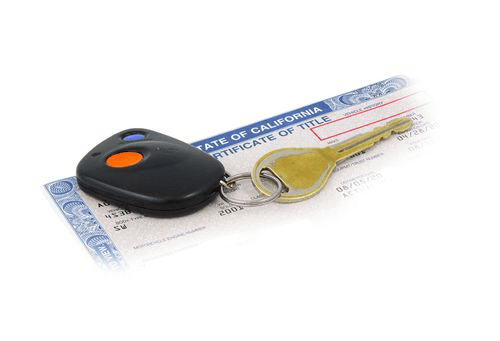Table of Contents
How Do You Sign Over a Car Title to a Buyer?
A car title is a legal document that is issued by the applicable state agency to prove ownership of a vehicle. Your car’s title will include your name, the Vehicle Identification Number (VIN), current mileage at the time of the transfer, and the make and model of the vehicle. Signing over your car’s title is another way to say that you are transferring the title to the new owner after the sale is completed. If you’ve just sold a vehicle or you have your car listed for sale, you might be wondering, “How do you sign over a car title?”
It’s important to understand how the title transfer process works in your state if you plan on selling your car to a private buyer. If you’re curious about how to sign a car title over, it generally involves physically filling out your car’s title with the necessary information and signing it. In some states, you and the buyer may be required to sign the title in the presence of a notary public. Once your car’s title has been appropriately filled out, the next step is to head to your local Department of Motor Vehicles (DMV) or state equivalent and release the ownership of your car by completing the title transfer process.
Required Documents for the Car Title Transfer Process

Before you can fully understand how to sign over a car title, it’s important to have the right documents on hand to complete a title transfer in your state. The title transfer process is usually somewhat similar from state to state, but some states may require that you provide extra paperwork if you need to sign over your car title to a new buyer. In certain states, such as Nebraska, you will need to have a signed bill of sale.
In general, you must have the following documents when completing a title transfer:
- Valid Form of Identification, Like a Driver’s License or REAL ID
- VIN Verification Form
- Proof of Insurance (In Some Cases)
- Proof of Registration
- Preferred Method of Payment to Complete a Title Transfer
In addition to these documents, you will need to fill out your car’s title and sign on the appropriate line. Signing on the wrong line can lead to unnecessary delays, because you may need a duplicate title if you make a mistake during this process. Use black or blue ink to sign your title to ensure the validity of your signature and avoid crossing out items or putting white-out over text.
Steps to Sign Over a Title for a Car
In many states, the title transfer process should be completed within 30 days of buying or selling a car, so the sooner you can handle it, the better! Make sure to visit the website of the relevant government agency in your state to get more information about the process to transfer your car’s title. As mentioned above, it can vary depending on your state of residence. In most cases, the steps to sign over a title for a car after it has been sold will include the following:
1. Sign the Title and Release Car Ownership
Whether you’ve listed your car on Facebook Marketplace or have found another avenue to complete a private vehicle sale, the next step is to release the ownership of your car. As the seller, you can sign the title at any time to start this process. If more than one person is listed on the title and the word “and” is between the names, then all owners will have to sign over the car title to complete the sale. When signing over your car’s title, you will be required to fill out the appropriate sections and provide your contact information, the current mileage of your car’s odometer reading, and the sale price of the vehicle.
2. Create a Bill of Sale (if Needed)
If you live in a state that requires a bill of sale to be included with the transfer of an automobile title to a new owner, the next step would be to complete the required form online or at your local government agency that handles title transfers. A bill of sale is essentially a receipt that provides detailed information about the purchase of a vehicle.
3. Head to the Dmv
After the title has been signed, the next step is to head to your local Department of Motor Vehicles or state equivalent to finish the transfer process. If this is a private sale, the new owner will be responsible for paying the sales tax and must register the car in their name after completing the title transfer process. When you purchase a vehicle from a dealership, the sales tax is already included in the sales price and the dealership will typically handle the title transfer process on your behalf.
Transferring a Car Title With an Outstanding Loan
Now that you understand how to sign over a car title, you might be wondering if there will be any hiccups during the title transfer process. In some cases, signing over a car title to a private buyer can be a little bit complicated. If you have an outstanding loan on your car, the lienholder’s name will be present on your car’s title. You cannot transfer ownership to a private buyer while there is a lien present on your car’s title from an auto lender or a title lender.
You can sell your car while you have a title loan or an auto loan, but you must pay off the remaining balance prior to completing the sale. Depending on the terms and conditions of your loan, you may be charged a prepayment penalty for paying off your loan before the term ends. After you’ve made the final payment on your loan, the lien is released from your car’s title.
If your state participates in the Electronic Lien and Title (ELT) system, your lender or lienholder will notify your state’s applicable government agency directly, and the lien-free title will be sent back to you in the mail. If there is no ELT system in your state or your lender does not participate in it, you may need to request a lien release form and handle the process yourself after receiving your car’s title in the mail. Once the clear title is back in your hands, you can apply for a title loan or sign over the car title to a new owner.
Tips for How to Sign Over a Title for a Car

Signing over a title for a car can often be a simple process when you are adequately prepared. As long as you have the required documents on hand and fill out the title where you are obligated to, you can often expect a smooth transfer of ownership! Remember to sign your car’s title over in black or blue ink and double-check all of your information to protect both the buyer and yourself.
However, keep in mind that even after you’ve signed the title over, the car is still legally your responsibility until the buyer registers it with their state’s appropriate government agency. It may be a smart idea to tag along with them to complete the car title transfer process and ensure that they have registered the vehicle in their name to avoid any complications.




